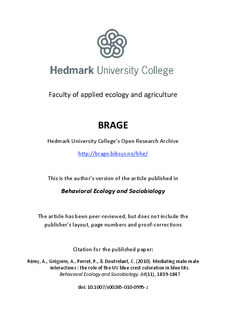| dc.contributor.author | Rémy, Alice | |
| dc.contributor.author | Grégoire, Arnaud | |
| dc.contributor.author | Perret, Philippe | |
| dc.contributor.author | Doutrelant, Claire | |
| dc.date.accessioned | 2012-12-17T09:20:12Z | |
| dc.date.available | 2012-12-17T09:20:12Z | |
| dc.date.issued | 2010 | |
| dc.identifier.citation | Rémy, A., Grégoire, A., Perret, P., & Doutrelant, C. (2010). Mediating male-male interactions : the role of the UV blue crest coloration in blue tits. Behavioral Ecology and Sociobiology, 64(11), 1839-1847. doi: 10.1007/s00265-010-0995-z | no_NO |
| dc.identifier.issn | 1432-0762 | |
| dc.identifier.uri | http://hdl.handle.net/11250/134462 | |
| dc.description | This is the postprint version of the article. The published article can be located here: http://link.springer.com/article/10.1007/s00265-010-0995-z?null | no_NO |
| dc.description.abstract | Badges of status, usually color patches, are hypothesised to serve as important
signals within natural populations by communicating individual’s fighting ability or aggressiveness before an interaction ever takes place. These signals, which may
evolve via sexual and/or social selection, mediate intra-specific competition by
influencing the outcome or escalation of contests between individuals. The last 10
years saw the rise of interest in the role of Ultraviolet (UV)-based coloration in
intra-sexual communication. However, the rare experimental studies that tested this
hypothesis found opposite results, which may originate from the different
methodological procedures used to assess badge of status theory. We present here
the results of an experiment testing whether male blue tits (Cyanistes caeruleus)
respond differently to unfamiliar conspecifics presenting contrasted UV crest
coloration. In an aviary, we simultaneously presented two caged blue tits with
enhanced (UV+) or reduced (UV-) crest coloration to a focal bird. We found that
focal males acted more aggressively towards the UV- males than UV+ males. In
addition, focal males fed more often close to males that were similar in brightness or
duller than themselves. We conclude that, in blue tits, UV-blue crest coloration
affects both social and aggressive responses towards unfamiliar individuals, and thus
it has some properties of a badge of status. | no_NO |
| dc.language.iso | eng | no_NO |
| dc.publisher | Springer | no_NO |
| dc.subject | badge of status | no_NO |
| dc.subject | structural coloration | no_NO |
| dc.subject | blue tit | no_NO |
| dc.subject | Cyanistes caeruleus | no_NO |
| dc.subject | intra-specific competition | no_NO |
| dc.title | Mediating male-male interactions: the role of the UV-blue crest coloration in blue tits | no_NO |
| dc.type | Journal article | no_NO |
| dc.type | Peer reviewed | no_NO |
| dc.subject.nsi | VDP::Mathematics and natural science: 400::Zoology and botany: 480 | no_NO |
| dc.source.pagenumber | 1839-1847 | no_NO |
| dc.source.volume | 64 | no_NO |
| dc.source.journal | Behavioral ecology and sociobiology | no_NO |
| dc.source.issue | 11 | no_NO |
| dc.identifier.doi | 10.1007/s00265-010-0995-z | |
